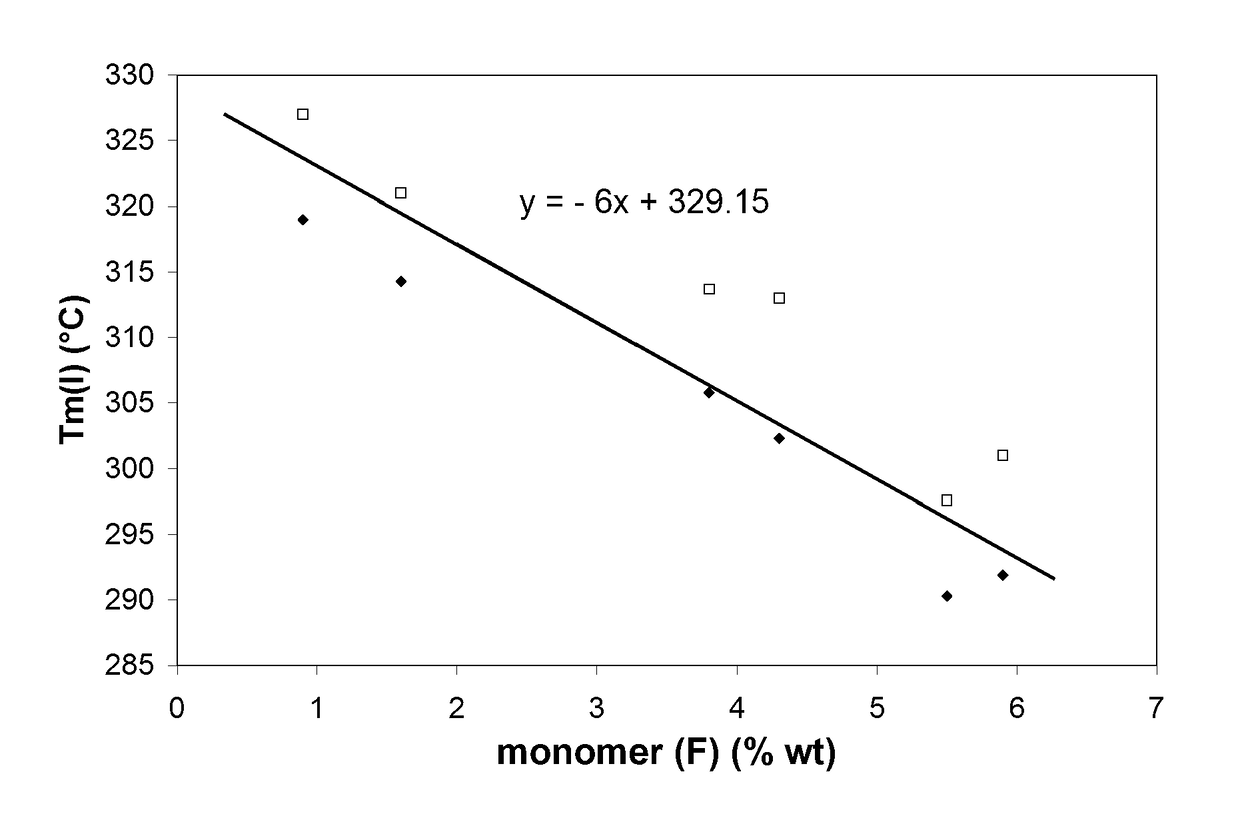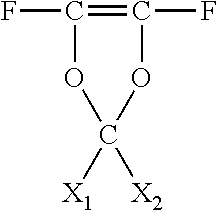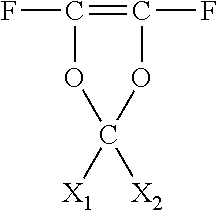Melt-processable perfluoropolymers having improved thermal and mechanical properties after heating treatment
a technology of perfluoropolymer and which is applied in the field of heat treating a meltprocessable perfluorinated tetrafluoroethylene polymer, can solve the problems of complicated polymer modification process, and achieve the effects of improving thermal and mechanical properties, improving flex life, and improving flex li
- Summary
- Abstract
- Description
- Claims
- Application Information
AI Technical Summary
Benefits of technology
Problems solved by technology
Method used
Image
Examples
example 1
[0090]A polymer sample (PFA 1, PFA 2, PFA 3, PFA 4, Poly-A, or Poly-B) as received was melt and subjected to MFI determination, shown as “original” MFI value in Table 1. After a 7-day heat treatment at 300° C. (“HT1”), a 2-day heat treatment at 310° C. (“HT2”), or a 7-day heat treatment at 285° C. (“HT3”), the MFI value was re-measured for each treated polymer, as indicated in Table 1.
[0091]
TABLE 1Sam-PVEHFPMVEEVETOT *MFI (g / 10 s)ple(IR % w)Org.HT1HT2HT3PFA0.9———0.95.0—1.2—1PFA1.6———1.62.30.76——2PFA3.8———3.82.00.5——3PFA4.3———4.315.25.7——4Poly-—1.91.81.85.57.0——1.0APoly-—0.91.33.75.929——3.5B* TOT = % w (MVE + EVE + PVE + HFP)
[0092]As shown in Table 1, the MFI of each tested PFA polymer significantly decreased after receiving the heat treatment.
example 2
[0093]The polymer samples of Example 1 (PFA 1, PFA 2, PFA 3, PFA 4, Poly-A and Poly-B) as received were subjected to the first and second melting temperature (“Tm(I)” and “Tm(II)”, org.) measurements described above. After a 7-day heat treatment at 300° C. (“HT1”), a 2-day heat treatment at 310° C. (“HT2”), or 7-day heat treatment at 285° C. (“HT3”), the first and second melting temperatures were re-measured for each heat-treated PFA polymer, indicated in Table 2.
[0094]
TABLE 2org.org.Tm(I)Tm(II)Tm(I)Sample(° C.)(° C.)HT3HT1HT2PFA 1319.0319.5327.0PFA 2314.3315.7319.2320.6321.0PFA 3305.8307.7313.7PFA 4302.3305.3313.0Poly-A291.9293.7301.0Poly-B290.3291.0297.6
[0095]As shown in Table 2, the first melting temperature of each tested polymer sample noticeably increased after heat treatment for a period of time, implying an increase in crystallinity for each heat-treated polymer sample.
[0096]FIG. 1 is a plot of first melting temperature [Tm(I), ° C.] as a function of weight percentage of com...
example 3
[0097]While tensile testing at ambient temperature (23° C.) is generally relied upon for determining continuous use temperature, it is also desirable to know the mechanical properties of the PFA polymers at a high temperature (e.g. 280° C.). Therefore, the PFA 2 polymer used in Examples 1 and 2 was subjected to mechanical property measurements as detailed above, and the results were compared for PFA 2 before and after the 2-day heat treatment at 310° C. (“HT2”), as shown in Table 3.
[0098]
TABLE 3Sample (PFA 2)Measuring TemperaturesMechanical Properties23° C.280° C.Mod. El. (MPa)44323Yield Stress (MPa)14.13Stress Break (MPa)30.66.2Elongation break (%)386495After HT2 (310° C., 2 days)Mod. El. (MPa)67628Yield Stress (MPa)14.62.9Stress Break (MPa)31.48.0Elongation break (%)492739
[0099]As shown in Table 3, the heat treatment of PFA 2 brought significant improvements in almost all aspects of tested mechanical properties, both at ambient temperature and at an elevated temperature as high as...
PUM
| Property | Measurement | Unit |
|---|---|---|
| temperature | aaaaa | aaaaa |
| temperature | aaaaa | aaaaa |
| temperature | aaaaa | aaaaa |
Abstract
Description
Claims
Application Information
 Login to View More
Login to View More - R&D
- Intellectual Property
- Life Sciences
- Materials
- Tech Scout
- Unparalleled Data Quality
- Higher Quality Content
- 60% Fewer Hallucinations
Browse by: Latest US Patents, China's latest patents, Technical Efficacy Thesaurus, Application Domain, Technology Topic, Popular Technical Reports.
© 2025 PatSnap. All rights reserved.Legal|Privacy policy|Modern Slavery Act Transparency Statement|Sitemap|About US| Contact US: help@patsnap.com



